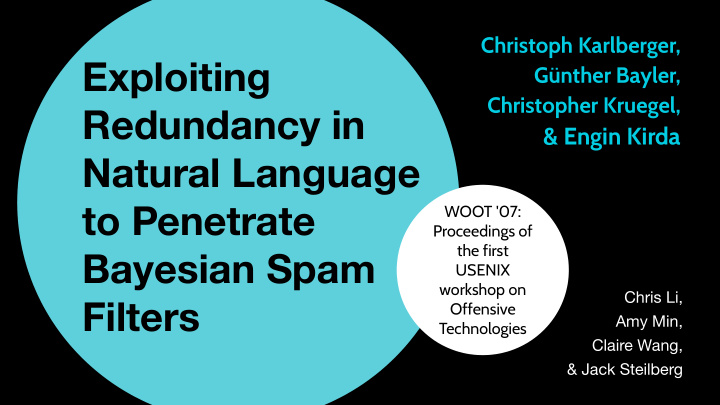



Christoph Karlberger, Exploiting Günther Bayler, Christopher Kruegel, Redundancy in & Engin Kirda Natural Language to Penetrate WOOT '07: Proceedings of the first Bayesian Spam USENIX workshop on Chris Li, Filters Offensive Amy Min, Technologies Claire Wang, & Jack Steilberg
Problem statement
Summary
What is in an email?
What is a Bayesian spam filter?
How does a Bayesian spam filter work? Calculating the probabilities for individual words Ham means not spam
Training a Bayesian spam filter 1. Tokenize emails 2. Analyze messages
Training a Bayesian filter 2. Analyze messages Formula derived from Bayes’ theorem combining individual probabilities
How it Works
1. Random 2. Common 3. Common Typical word word word attacks: attack attack + Appending uncommon filler words in spam attack
Synsets Hypernym sets If no synonym sets Alternate a → @ “an automobile with “motor vehicle” four wheels” attack: i → l (lower case L) Substitution “a motor vehicle “automobile” with four wheels” Car: “a cabin for transporting people”
1. Identify all words with high spam probability Automating 2. Find a synonym set with a Substitution lower spam probability Attacks 3. Replace words in the email with one of the synonym sets 4. Test altered email against spam filter
1. Identifying all words with high spam probability Training spam filters with spam and ham emails: 1. Find the spam probability of every word 2. Use a substitution threshold
2. Finding sets of words with similar meaning 1. Find synonym sets using WordNet a. If none found, use exchange threshold for doing e.g. a → @ 2. Give WordNet the role of the word using LingPipe NLP package 3. Use SenseLearner to choose the synset closest semantically to the original term
3. Replacing words in the email Two methods of selecting from the set of synonym sets found: 1. Random 2. Minimum spam probability
Results
Evaluation Results were evaluated with three different spam filters ● SpamAssassin 3.1.4 ○ DSPAM 3.8.0 ○ Gmail ○ Spam emails obtained from Bruce Guenter’s SPAM archive ●
Evaluation HTML stripped from messages ● Manually corrected pre-existing word-alternation based filter ● attacks ○ E.g. “he==llo” => “hello”
Data Incorrectly Classified as non-SPAM Incorrectly Classified SPAM Group (A is control)
Data (uglier)
Limitations ● Substitution was not always able to find a good word to use ○ Instead do character exchanges, but those do not usually fool spam filters ● Sometimes word substitutions do not make sense to a human ● Spam often has bad grammar which makes substitution more difficult
Later Research
Mostly ways to counter the attack proposed in our paper
Enhanced VSM Models natural language ❖ Topic-based Used in information retrieval ❖ Treats words as independent ❖ Vector Space eTVSM Model for Accounts for meaning ❖ Topics → interpretations → ❖ semantics-aware terms [3] spam filtering [2] 2012 Igor Santos, Carlos Laorden, Borja Sanz, and Pablo G. Bringas
2012 - eTVSM Trained Successfully Represented machine identified emails with learning many spam eVTSM messages classifiers
Evasion-Robust ❖ Our paper was an Classification evasion attack on Binary ➢ Intelligent adversary Domains [4] ❖ And had a binary feature space 2018 Bo Li and Yevgeniy Vorobeychik
2018 - Evasion-Robust Classification Authors created 2 frameworks ❖ General ➢ Mixed-integer linear programming ■ Accounts for feature cross-substitution attacks ■ RAD ➢ Algorithm for retraining with arbitrary attack models & classifiers ■ And tested them ❖ Filtering spam ➢ Identifying handwritten numbers ➢ 27
Opportunities to do similar research NEU SecLab - practical security Security applications of program analysis ❖ Web & mobile security ❖ Malware ❖ Botnets ❖ Basic knowledge of security is helpful https://seclab.ccs.neu.edu/ ek@ccs.neu.edu
Conclusion Spam emails are a serious concern and major annoyance ❖ Bayesian spam filters are an important technology for ❖ removing spam They are not perfect and can be fooled by substitution ❖ Replacing suspicious words with more innocuous ones ➢ This can be used to improve filters in the future ➢ This shows we need more improvements to filter spam ❖ 29
References [1] Christoph Karlberger, Günther Bayler, Christopher Kruegel, and Engin Kirda. 2007. Exploiting redundancy in natural language to penetrate Bayesian spam filters. WOOT ‘07: Proceedings of the first USENIX workshop on Offensive Technologies , Article 9 (2007), 7 pages. [2] Igor Santos, Carlos Laorden, Borja Sanz, and Pablo G. Bringas. 2011. Enhanced Topic-based Vector Space Model for semantics-aware spam filtering. Expert Systems with Applications 39, 1 (Jan. 2012), 437-444. DOI: https://doi.org/10.1016/j.eswa.2011.07.034 [3] Ahmed Awad, Artem Polyvyanyy, and Mathias Weske. 2008. Semantic Querying of Business Process Models. 12th International IEEE Enterprise Distributed Object Computing Conference (2008), 85-94. DOI: https://doi.org/10.1109/EDOC.2008.11 [4] Bo Li and Yevgeniy Vorobeychik. 2018. Evasion-Robust Classification on Binary Domains. ACM Trans. Knowl. Discov. Data . 12, 4, Article 50 (June 2018), 32 pages. DOI: https://doi.org/10.1145/3186282 30
Recommend
More recommend